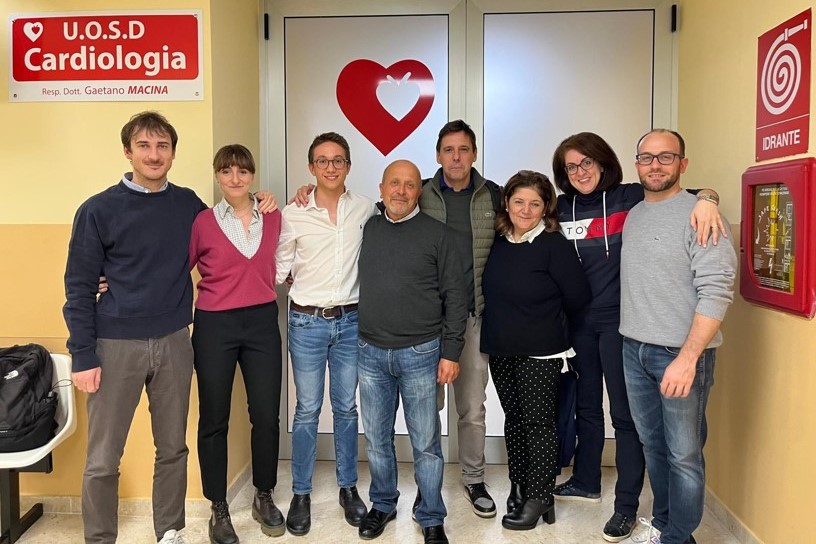News
DOCTORS AT SAN RAFFAELE HOSPITAL DISCOVER NEW MUTATION LINKED TO SUDDEN CARDIAC DEATH
A multidisciplinary team of geneticists, cardiologists, and neurologists at IRCCS San Raffaele Hospital have identified a previously undescribed genetic mutation in the LMNA gene, associated with cardiomyopathy and neuromuscular disorders, through a genetic-clinical screening involving 234 individuals originally from Caposele, a small town in the Campania region of southern Italy.
The results were published on July 15th, 2025 in the Journal of the American College of Cardiology Advances (JACC): Heart Failure. The study identified a new genetic mutation in the LMNA gene that was found to be associated with a severe form of cardiomyopathy and milder neuromuscular symptoms.
The discovery is the result of genetic screening combined with clinical evaluations conducted thanks to a unique collaboration of San Raffaele neurologists, cardiologists, and geneticists who assessed 234 individuals belonging to a single family tree from Caposele, a small town located 100km east of Naples.
The analysis identified 30 carriers of the new mutation, accounting for 12.8% of the sample.
All carriers (100%) showed cardiac abnormalities, many of which were previously unknown and untreated, and approximately 43% showed signs of neuromuscular involvement. In some individuals, early diagnosis enabled life-saving interventions such as implantable defibrillators or heart transplant evaluations.
The screening campaign began in 2022 and concluded in June 2024, made possible thanks to the extraordinary participation of the local civil and medical community.
The project was carried out by seven specialists from San Raffaele, led by Dr. Simone Sala, cardiologist and arrhythmologist at IRCCS San Raffaele Hospital, in collaboration with Stefano Previtali, neurologist at San Raffaele and Associate Professor at Vita-Salute San Raffaele University, and Professor Chiara Di Resta, Assistant Professor at the School of Medicine of the same university and researcher in the Genomics Unit for human disease diagnosis at IRCCS Hospital San Raffaele.
The multidisciplinary research team involved in the study
LMNA Mutations and Laminopathies
Lamins are essential proteins for the structure and stability of the cell nucleus, forming its internal "skeleton" that protects genetic material and regulates many nuclear functions.
Mutations in the LMNA gene—which provides instructions for producing lamins—can cause a family of disorders known as laminopathies. These diseases have a broad range of clinical manifestations, including cardiac anomalies due to progressive deterioration of heart function, and neuromuscular symptoms.
Some LMNA mutations are also responsible for rare and severe conditions such as Hutchinson-Gilford progeria syndrome, which causes premature aging starting in childhood. This syndrome has received particular attention in Italy thanks to the advocacy of the young researcher Sammy Basso, who was affected by the condition.
In addition to progeria, laminopathies also include familial cardiomyopathies, muscular dystrophies, and other complex neuromuscular disorders.
“The new LMNA mutation identified in our study consists of the deletion of a single DNA base, which may result in a non-functional protein,” explains Prof. Chiara Di Resta. “This causes structural fragility in cells, which over time can lead to dilated cardiomyopathy: the heart enlarges, loses contractile strength, and its electrical conduction system becomes impaired.”
“In all carriers of this newly identified mutation, we observed cardiac involvement. The early symptoms can be mild and underestimated, but there is a real risk of sudden deterioration,” adds Dr. Simone Sala. “These cardiac alterations can affect the heart’s ability to conduct electrical signals, leading to severe arrhythmias even in the absence of initial symptoms.”
Professor Stefano Previtali adds: “Although primarily causing cardiac dysfunction, the new mutation also results in neuromuscular involvement in around 40% of carriers. Symptoms may include muscle weakness and motor difficulties, varying in severity and onset.”


Part of the research team with Angelomaria Sista (4th from the left), the patient who helped with the genealogy reconstruction, and Gelsomina Cione (6th from the left), his cardiologist. The picture was taken in the Cardiology Department in Sant'Angelo dei Lombardi
The Story of Caposele
In 2021, a young woman visited Dr. Simone Sala’s clinic at San Raffaele to investigate mild episodes of irregular heart rhythm. What truly alarmed the doctor, however, was the patient’s family history—several young, seemingly healthy relatives had died suddenly from unexplained cardiac arrest.
“A light bulb went off,” Dr. Sala recalls. “It wasn’t just arrhythmia—there was something recurring in the patient’s family history that needed urgent investigation.”
Given the specific cardiac abnormalities, he suspected a form of laminopathy. Geneticist Chiara Di Resta conducted genetic testing on the patient and confirmed the hypothesis: the patient carried a previously undescribed mutation in the LMNA gene, designated c.208del by the study’s authors.
“The c.208del mutation carries a high risk of malignant arrhythmias and sudden death,” explains Dr. Di Resta, “but also causes mild neuromuscular symptoms. Our first priority was to protect the patient.”
As a preventive measure, Dr. Sala implanted a defibrillator, which proved to be life-saving when the patient suffered cardiac arrest only a few months later.
Soon after, a second patient originally from Caposele with a history of severe arrhythmias visited Dr. Sala, reporting several cases of sudden death and family members with limping. He too was found to carry the c.208del mutation.
Remarkably, this man had collaborated with his cousin, the local community, and even descendants of Caposele emigrants in America, to digitally reconstruct a genealogical tree of nearly 3,000 individuals using parish records, old legal documents, and open-source tools. The family line traced back to a common ancestor born in 1689, covering 12 generations.
Based on this genealogical reconstruction, the San Raffaele team was able to identify living individuals likely to be carriers of the new mutation.
Given the autosomal dominant nature of the mutation—requiring only one altered gene copy to develop the disease—the team identified at-risk individuals early and invited them for genetic and clinical screenings.
To optimize the selection and assessment of LMNA mutation carriers, the team also used an artificial intelligence algorithm that predicted genetic status from biometric data, electrocardiograms, and echocardiograms with up to 90% accuracy. This innovative approach improved the effectiveness of screening and personalized patient management in the genetically isolated context of Caposele.
The community response was extraordinary: over 90% of those contacted were eager to participate, making this one of the most extensive genetic screenings ever conducted in a geographically isolated population in southern Italy.
“At a time when research often seems to belong only in laboratories, the Caposele experience flips the script: here, science emerged from the community,” conclude Sala, Previtali, and Di Resta.
“It was the incredible ‘collective memory’ work of the Caposele people that laid the foundation for genetic tracing. Entire families came together to undergo testing, talk with doctors, and understand the risks and opportunities of this investigation. This model of citizen science—where citizens, clinicians, and researchers collaborate as equals—shows that shared knowledge can truly make a difference. The community’s contribution wasn’t just logistical or numerical, but deeply human. It enabled a new way of practicing medicine—based on trust, identity, and the memory of a territory.”
Published on: 21/07/2025
Authors: Camilla Pisciotta and Laura Celotto
